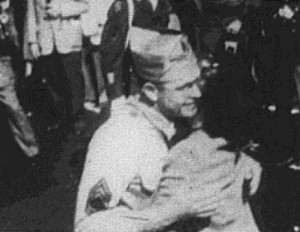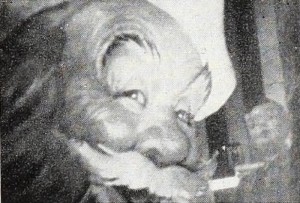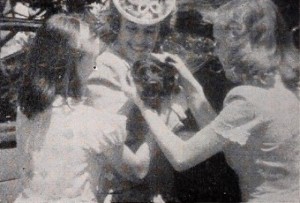"The Visible Woman is an attractive little package about a woman who tries to construct a visible woman. Doesn't sound like much of a theme, does it? But with a parallel in counterpoint between herself and her son, the injection of a cat that at times steals the show, and a real twist at the end, this well lighted and well photographed little gem is one you'll remember for quite a spell. Probably its finest feature is its editing - great" PSA Journal, Sept. 1964, 51.
"Playful family montage by the experimental filmmaker who headed the USC School of Cinematic Arts from 1949 to 1951" centerforhomemovies.org
A film capturing slices of everyday life, narrativizing Mori’s small children playing with each other.

"To capture the spirit of a day-long welcome to homecoming Korean veterans is not an easy task. But Pete Delaurenti has managed it in a remarkably complete coverage in true newsreel style. Cutting from shots of the great troopship edging up to the dock in Seattle, to the crowds waiting to embrace returning veterans - the genuine and touching family reunions, the slightly bewildered beauty queens, the governors' paternal reception of a chosen native of each state and the inevitable parades - Mr. Delaurenti seems to have been endowed with multiple hands, feet and even cameras. Welcome Lane is a moving record of a difficult subject, accomplished with good taste" PSA Journal, Jan. 1955, 51.
"Members of the Morley family are seen walking through the countryside and a forest area. They are seen relaxing on a beach. Includes shots of the children paddling in the sea; making sand castles and watching a Punch and Judy Show. Continues with various activities talking place around a harbour. A group of fishermen are seen standing on the quayside - smoking, talking and securing their boats. Also features scenes of the countryside around Whitby and the lakes. Concludes with footage of a little girl playing on a homemade swing hanging from a tree; stroking a donkey in a field; playing pitch and putt golf and dancing around in circles with a woman; as they walk along a country lane" (NWFA Online Database).
"Whither Flowing," depicts the nervous evils caused by parents in the thoughtless upbringing of children. The drama was compactly told, well acted and directed, and was marked by unusual photography." Photoplay, Nov. 1929, 67. "...Whither Flowing is a psychological study of hysteria.... Dr. Heise's Whither Flowing won second award in the dramatic division of the recent Photoplay Magazine contest...” Movie Makers, Feb. 1930, 104.

"Edited film is the story of the Kreznar family vacation to Florida created by Frank Kreznar, an award winning amateur filmmaker and engineer. The youngest daughter is instructed by a teacher to keep a notebook of her experiences in Florida which include visiting a Florida visitor center, setting up camp in a park, watching a water skiing performance, visiting a marine animal park where they watch a dolphin show, touring the Everglades on an air powered boat, riding on a glass bottom boat, viewing bird and animal wildlife and swimming at a beach. Sound is the daughter's narration of their experiences," via the Human Studies Film Archives, Smithsonian Museum.

"Most Christmas films seem to be concerned with only one aspect of this December holiday — the gaiety of family life around the tree, opening presents and a festive dinner. Grace Lindner has recorded the material side of the season in the early footage of her film, Xmas Time, as she shows gleaming shop windows, hurrying shoppers, decorated doorways and members of her family around the hearthside. But in a smooth transition from a creche under the tree to the children saying their prayers, she ends her film with a series of architectural studies of the spires and bell towers of churches, filmed through bleak branches against a winter sky. This moving climax, accompanied by a choir recording of The Lord's Prayer, admirably fulfills her aim to portray the triumph of the spirit of Christmas over the baser observances." Movie Makers, Dec. 1951, 412.

"Young Fella is a teaching film; it is also a family film. Again Walter Bergmann presents his charming household and shows the devotion of its members for pets. This time it is a young cocker spaniel that is the star. Subtitles on the proper care of dogs point up the scenes which demonstrate the advice given, as to feeding, bathing, playing and proper use of a run. Young Fella is an appealing pup and a willing actor, but the Bergmann cats steal some of the scenes in typical fashion." Movie Makers, Dec. 1948, 496.
Total Pages: 15